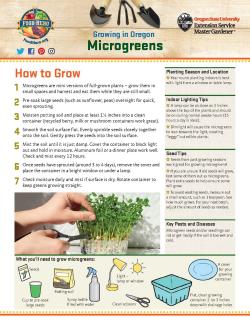How to Grow
- Microgreens are mini versions of full-grown plants - grow them in small spaces and harvest and eat them while they are still small.
- Pre-soak large seeds (such as sunflower, peas) overnight for quick, even sprouting.
- Moisten potting soil and place at least 1½ inches into a clean container (recycled berry, milk or mushroom containers work great).
- Smooth the soil surface flat. Evenly sprinkle seeds closely together onto the soil. Gently press the seeds into the soil surface.
- Mist the soil until it is just damp. Cover the container to block light out and hold in moisture. Aluminum foil or a dinner plate work well. Check and mist every 12 hours.
- Once seeds have sprouted (around 3 to 4 days), remove the cover and place the container in a bright window or under a lamp.
- Check moisture daily and mist if surface is dry. Rotate container to keep greens growing straight.
Planting Season and Location
- Year-round planting indoors is best with light from a window or table lamp.
Indoor Lighting Tips
- A lamp can be as close as 3 inches above the top of the plants and should be on during normal awake hours (15 hours a day is ideal).
- Dim light will cause the microgreens to lean towards the light, creating “leggy” but edible plants.
Seed Tips
- Seeds from past growing seasons work great for growing microgreens!
- If you are unsure if old seeds will grow, test some of them out as microgreens. Plant extra seeds to help ensure some will grow.
- To avoid wasting seeds, measure out a small amount, such as 1 teaspoon. See how much grows. For your next batch, adjust the amount of seeds as needed.
Key Pests and Diseases
- Microgreen seeds and/or seedlings can rot or get moldy if the soil is too wet and cold.
What You'll Need to Grow Microgreens
- Seeds
- Cup to pre-soak large seeds
- Potting soil
- Spray bottle filled with water
- Light-lamp or window
- Clean scissors
- Flat, clean growing container 2 to 3 inches deep with drainage holes
- A cover for your growing container
Some Types to Grow
- Mild: broccoli, cabbage, cilantro*, chard, kale, peas, sunflower
- Spicy: arugula, mustard greens, radish
* Might take longer to harvest, but worth the wait
Avoid using these seed types for microgreens: eggplants, peppers, tomatoes, tomatillos
When and How to Harvest
- Many microgreens are ready to eat in 10 to 14 days. Use clean scissors to cut off above the soil.
Storage and Cooking
- Best plan is to harvest, rinse, and use right away. To store, wrap in a paper towel and place in a plastic bag for 1 to 2 days in the refrigerator.
- Microgreens are packed with nutrients, even more than their full-grown plant, and they add a burst of flavor, texture and color to meals.
- Microgreens grow super-fast and are easy for kids’ hands to rinse and then sprinkle on meals to promote cooking and tasting!
- Try growing and tasting different types of microgreens to find which type or mixture you like best!
- Try this Food Hero recipe: Cilantro Lime Tuna Wrap



